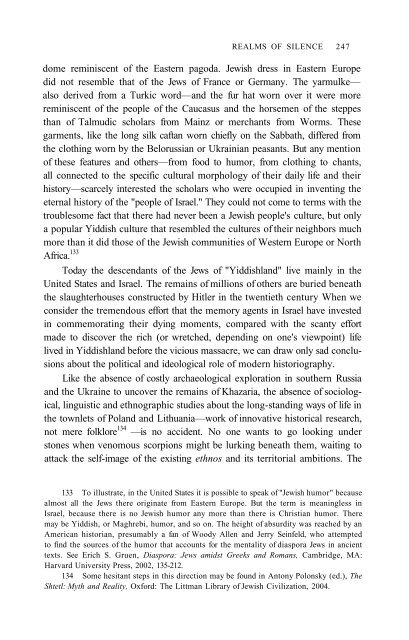Shlomo Sand, The Invention of the Jewish People - Rafapal
Shlomo Sand, The Invention of the Jewish People - Rafapal
Shlomo Sand, The Invention of the Jewish People - Rafapal
You also want an ePaper? Increase the reach of your titles
YUMPU automatically turns print PDFs into web optimized ePapers that Google loves.
REALMS OF SILENCE 247<br />
dome reminiscent <strong>of</strong> <strong>the</strong> Eastern pagoda. <strong>Jewish</strong> dress in Eastern Europe<br />
did not resemble that <strong>of</strong> <strong>the</strong> Jews <strong>of</strong> France or Germany. <strong>The</strong> yarmulke—<br />
also derived from a Turkic word—and <strong>the</strong> fur hat worn over it were more<br />
reminiscent <strong>of</strong> <strong>the</strong> people <strong>of</strong> <strong>the</strong> Caucasus and <strong>the</strong> horsemen <strong>of</strong> <strong>the</strong> steppes<br />
than <strong>of</strong> Talmudic scholars from Mainz or merchants from Worms. <strong>The</strong>se<br />
garments, like <strong>the</strong> long silk caftan worn chiefly on <strong>the</strong> Sabbath, differed from<br />
<strong>the</strong> clothing worn by <strong>the</strong> Belorussian or Ukrainian peasants. But any mention<br />
<strong>of</strong> <strong>the</strong>se features and o<strong>the</strong>rs—from food to humor, from clothing to chants,<br />
all connected to <strong>the</strong> specific cultural morphology <strong>of</strong> <strong>the</strong>ir daily life and <strong>the</strong>ir<br />
history—scarcely interested <strong>the</strong> scholars who were occupied in inventing <strong>the</strong><br />
eternal history <strong>of</strong> <strong>the</strong> "people <strong>of</strong> Israel." <strong>The</strong>y could not come to terms with <strong>the</strong><br />
troublesome fact that <strong>the</strong>re had never been a <strong>Jewish</strong> people's culture, but only<br />
a popular Yiddish culture that resembled <strong>the</strong> cultures <strong>of</strong> <strong>the</strong>ir neighbors much<br />
more than it did those <strong>of</strong> <strong>the</strong> <strong>Jewish</strong> communities <strong>of</strong> Western Europe or North<br />
Africa. 133<br />
Today <strong>the</strong> descendants <strong>of</strong> <strong>the</strong> Jews <strong>of</strong> "Yiddishland" live mainly in <strong>the</strong><br />
United States and Israel. <strong>The</strong> remains <strong>of</strong> millions <strong>of</strong> o<strong>the</strong>rs are buried beneath<br />
<strong>the</strong> slaughterhouses constructed by Hitler in <strong>the</strong> twentieth century When we<br />
consider <strong>the</strong> tremendous effort that <strong>the</strong> memory agents in Israel have invested<br />
in commemorating <strong>the</strong>ir dying moments, compared with <strong>the</strong> scanty effort<br />
made to discover <strong>the</strong> rich (or wretched, depending on one's viewpoint) life<br />
lived in Yiddishland before <strong>the</strong> vicious massacre, we can draw only sad conclusions<br />
about <strong>the</strong> political and ideological role <strong>of</strong> modern historiography.<br />
Like <strong>the</strong> absence <strong>of</strong> costly archaeological exploration in sou<strong>the</strong>rn Russia<br />
and <strong>the</strong> Ukraine to uncover <strong>the</strong> remains <strong>of</strong> Khazaria, <strong>the</strong> absence <strong>of</strong> sociological,<br />
linguistic and ethnographic studies about <strong>the</strong> long-standing ways <strong>of</strong> life in<br />
<strong>the</strong> townlets <strong>of</strong> Poland and Lithuania—work <strong>of</strong> innovative historical research,<br />
not mere folklore 134 —is no accident. No one wants to go looking under<br />
stones when venomous scorpions might be lurking beneath <strong>the</strong>m, waiting to<br />
attack <strong>the</strong> self-image <strong>of</strong> <strong>the</strong> existing ethnos and its territorial ambitions. <strong>The</strong><br />
133 To illustrate, in <strong>the</strong> United States it is possible to speak <strong>of</strong> "<strong>Jewish</strong> humor" because<br />
almost all <strong>the</strong> Jews <strong>the</strong>re originate from Eastern Europe. But <strong>the</strong> term is meaningless in<br />
Israel, because <strong>the</strong>re is no <strong>Jewish</strong> humor any more than <strong>the</strong>re is Christian humor. <strong>The</strong>re<br />
may be Yiddish, or Maghrebi, humor, and so on. <strong>The</strong> height <strong>of</strong> absurdity was reached by an<br />
American historian, presumably a fan <strong>of</strong> Woody Allen and Jerry Seinfeld, who attempted<br />
to find <strong>the</strong> sources <strong>of</strong> <strong>the</strong> humor that accounts for <strong>the</strong> mentality <strong>of</strong> diaspora Jews in ancient<br />
texts. See Erich S. Gruen, Diaspora: Jews amidst Greeks and Romans, Cambridge, MA:<br />
Harvard University Press, 2002, 135-212.<br />
134 Some hesitant steps in this direction may be found in Antony Polonsky (ed.), <strong>The</strong><br />
Shtetl: Myth and Reality, Oxford: <strong>The</strong> Littman Library <strong>of</strong> <strong>Jewish</strong> Civilization, 2004.




